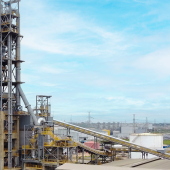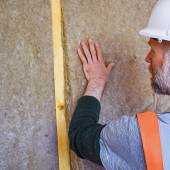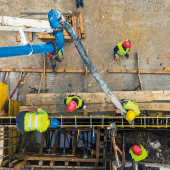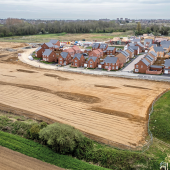New measures to minimise impact of RAAC in education settings

The government has published new measures to minimise the impact of reinforced autoclaved aerated concrete (RAAC) in education settings after a beam collapsed at a school during the summer that previously was thought to pose no risk to the public.
According to the Department for Education (DfE) the emergence of new RAAC cases has reduced its confidence that school, college and maintained nursery school buildings with confirmed RAAC should remain open without first putting mitigating measures in place to make the buildings safe.
Published last Thursday (31 August), the guidance provides advice to responsible bodies of state-funded education estates in England on how to identify RAAC and what to do if it is confirmed, including vacating and restricting access to spaces where RAAC has been confirmed. The guidance advises that spaces should remain out of use until appropriate mitigations are put in place.
To minimise the disruption caused, the government says all education settings with confirmed RAAC will receive support from a dedicated caseworker who will help the responsible bodies through any necessary changes.
RAAC is a lightweight form of precast concrete that was used extensively in public sector buildings, including schools, from the 1950s through to the mid-1990s.
According to the Health and Safety Executive’s guidance note on managing the risk from RAAC, it is mainly found in roofs, although occasionally in floors and walls. The HSE warns it is less durable than traditional concrete and there have been problems as a result, which could have significant safety consequences.
The Institution of Structural Engineers (IStructE) adds that if RAAC installations are properly designed, manufactured, in good condition and with good bearing, they should be considered safe.
"However, the panels can creep and deflect over time, and this can be exacerbated by water penetration," it warns. "A more recent incident indicated that if they have insufficient bearing and their structural integrity is compromised, they can fracture and collapse with little or no warning."
The government has sought to reassure the public and points out that there are more than 22,000 schools and colleges and less than 1% is known to be affected. Also, it adds that 31% of the buildings have been constructed since 2001 when RAAC was no longer used.
This week the DfE reported that of the 156 schools where it has been confirmed RAAC is present, 52 have already been supported to put mitigation measures in place.
However, the department added that it contacted the remaining 104 schools last week asking them to vacate spaces or buildings that are known to contain RAAC. This means they will not open to their full capacity when the autumn term starts while measures are put in place to make them safe.
The New Civil Engineer reported that at least 24 or the 104 remaining schools that have no safety measures in place will have to fully close. It also reported that 34 hospitals were known to contain RAAC.
The government says it has been aware of public sector buildings that contain RAAC since 1994 and has been monitoring their condition since 2018. Last year, DfE sent a questionnaire to all responsible bodies, asking them to provide information so it could better understand the use of RAAC across the school estate and tailor support accordingly.
On 20 June, Baroness Barran, Parliamentary Under-Secretary of State for DfE, confirmed in a parliamentary debate on the safety of school buildings that nearly 90% of schools and responsible bodies had sent in their initial responses to this questionnaire.
However, the government has been heavily criticised by opposition parties over its handling of the situation who add the actual scale of the RAAC risk could be much greater because the material was also used across the public sector in healthcare settings, courts and offices.
Learn more from the experts about RAAC at Built Environment Live. Register for your free place here.
The HSE’s guidance notes that anyone responsible for the management, maintenance or alteration of central and local government buildings should know whether their buildings contain RAAC and act appropriately to ensure that the buildings are safe.
A year ago today (on 7 September 2022), the Office of Government Property (OGP) sent a ‘Safety Briefing Notice’ to all property leaders highlighting the dangers posed by RAAC.
In November 2022, the Local Government Association reproduced the briefing notice for the benefit of councils.
"Action is already being taken by the OGP to set standards in this area to support organisations to meet their operational responsibility in addressing the risks of RAAC," noted the letter.
"Visually, RAAC planks may look the same as precast concrete, and may be hidden above false ceilings. For initial identification of RAAC in existing buildings, it may be necessary to engage an appropriately qualified and experienced construction professional, for example a chartered structural engineer, a registered architect or a chartered surveyor."
The OPG added that when the presence of RAAC is confirmed, a structural assessment should be carried out.
"Assessment of RAAC is a highly-specialised area within the structural engineering profession, and it is important to ensure that those providing structural engineering services are suitably qualified and can demonstrate an appropriate level of skill and experience."
The IStructE issued its own guidance about RAAC in 2022, which looked at the investigation and assessment. This was followed in 2023 with further guidance, including a risk assessment matrix.
Speaking to Building Engineer, Patrick Hayes, Technical Director at IStructE, said: "Both guides help structural engineers and their clients manage this situation which needs careful assessment and possible remediation. To help inform present and future thinking, we have also established a RAAC study group and created a list of professionally-qualified structural engineers who can provide technical solutions for assessing and managing RAAC planks."









